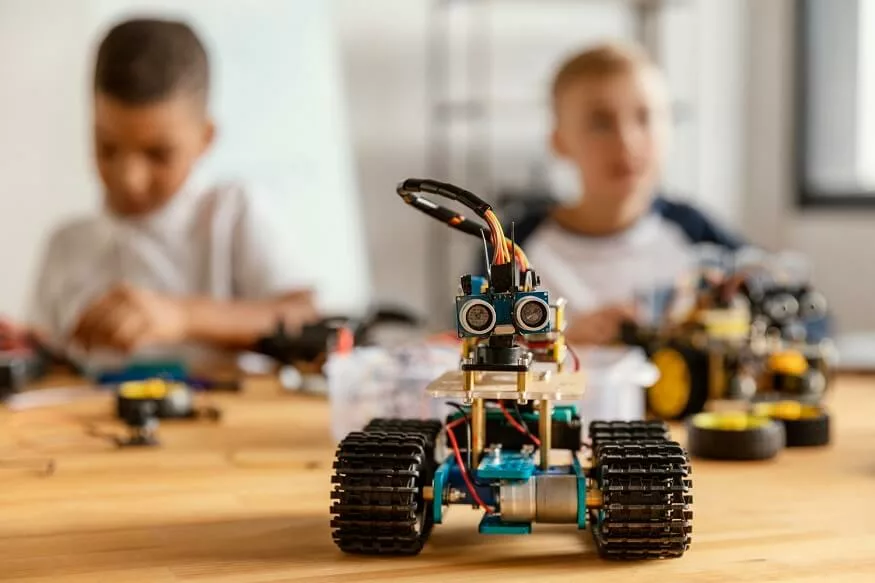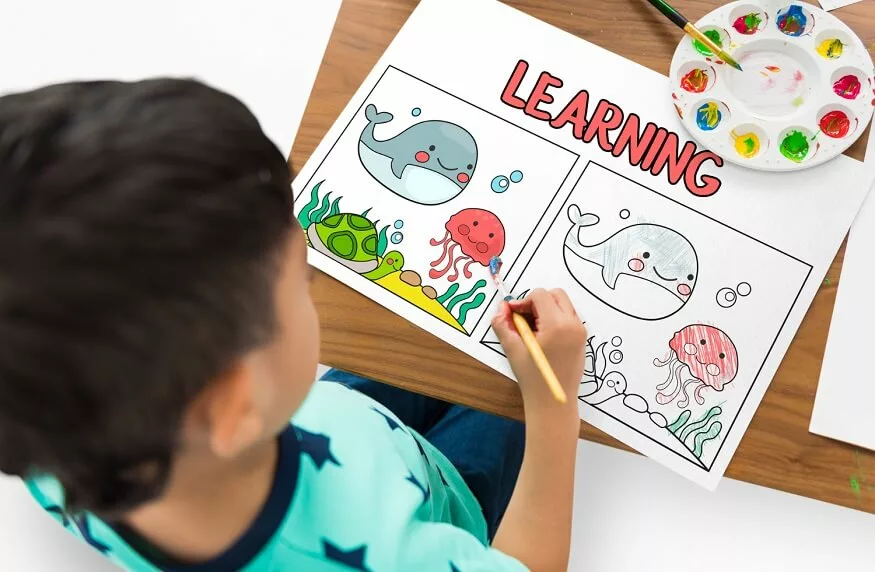Imagine having a toy robot that you can program to dance or draw pictures. That’s just one fun way to use robotics. Robotics is an area of technology that includes the development, operation, and design of robots. Robots are mechanical devices that are designed to do tasks independently, frequently imitating human behaviours. Students have recently expressed a strong interest in robots.
Learning about robotics gives children many benefits in today’s world. Firstly, it increases their problem solving and critical thinking skills as they explore how to program and control robots. This promotes creativity, logical reasoning, and innovation, which are essential skills for future success. Then, robotics helps children to develop a deeper understanding of STEM -Science, Technology, Engineering, and Mathematics concepts, fostering a passion for these fields at an early age.
Furthermore, robotics enhances teamwork and collaboration among children, as they often work in groups to design and build robots. It also includes perseverance and resilience, as they encounter challenges and setbacks while troubleshooting and refining their creations. Furthermore, learning about robotics gives youngsters a look into the future by introducing them to developing technologies and preparing them for a society in which automation and artificial intelligence play key roles.
Because of the rising significance of automation and technology in today’s environment, an introduction to robotics is essential. Children can reach their abilities and become active players in shaping the future of technology by accepting robotics education. In general, robotics education presents kids with critical skills, stimulates their interest, and educates them with the tools they need to succeed in the future’s technologically advanced world.
Also Read : How Technology Education Can Prepare Children for the Future
Robotics Projects for Children:
Engaging in robotics projects can be an excellent way for school students to learn and explore the field of robotics while developing a range of valuable skills. Here are a few project ideas suitable for school students:
1. Line-following robot:
Students can build a robot that follows a black line on a white surface using sensors and programming. This project helps students understand the basics of sensor integration and programming logic.
2. Obstacle-avoiding robot:
Students can design a robot that detects and avoids obstacles using ultrasonic sensors. This project enhances their understanding of sensor technologies and problem-solving skills.
3. Robotic arm:
Students can construct a robotic arm that mimics human movements. This project introduces them to mechanical design, motors, and control mechanisms.
4. Sumo robot:
Students can build small robots that compete in a sumo ring, aiming to push their opponent out. This project involves mechanical design, motor control, and strategy development.
Also Read: 16 Spatial Reasoning Activities for Kids
How to spark a kid’s interest in robotics?
Hands-on Experiences:
Provide opportunities for children to have hands-on experiences with robots. This can include using robot kits, attending robotics workshops, or participating in robotics clubs or camps. Let them experiment, build, and play with robots to experience the excitement first hand.
Show Real-World Applications:
Share stories and videos about how robots are used in various fields, such as space exploration, medicine, or everyday tasks. Help children understand the practical applications of robotics and how it impacts our lives.
Encourage Creativity:
Foster creativity by allowing kids to design and build their own robots using recyclable materials or robotics kits. Encourage them to think out of the box and Let them make unique ideas for their creations.
Make it Playful:
Incorporate playfulness into robotics activities. For example, set up robot races, create challenges for robots to overcome, or have robot dance parties. Making it fun and playful can keep children engaged and eager to explore more.
Role Models and Inspiration:
Introduce children to inspiring individuals in the field of robotics, such as inventors, engineers, or astronauts. Learning about their achievements and hearing their stories can inspire kids to pursue their own robotics interests.
Provide Support and Resources:
Ensure that children have access to resources like books, online tutorials, or educational websites focused on robotics. These resources can help them learn and explore robotics at their own pace.
Collaborative Projects:
Encourage collaboration and teamwork by organizing group robotics projects. This allows children to work together, share ideas, and learn from one another. Collaboration develops a sense of community and makes the learning experience more enjoyable.
Celebrate Achievements:
Acknowledge and celebrate children’s accomplishments in robotics. Display their robot creations, organize showcases or competitions, and recognize their efforts. Positive reinforcement boosts their confidence and motivates them to continue their robotics journey.
Also read : Positive & Negative Effects of Video Games on Children
Challenges of Learning Robotics for Kids:
Robotics involves understanding mechanical components, electronics, and programming, which can be initially challenging for kids. They may need guidance and support from teachers, mentors, or parents to overcome these technical complexities.
Robotics for kids often requires specialized equipment, sensors, and software, which may not be readily available in all educational settings. Limited access to resources can hinder the hands-on learning experience and limit the scope of robotics projects for some kids.
Robotics for kids involves a steep learning curve, particularly in programming and coding. Kids may need time and practice to grasp the concepts and develop proficiency in these areas.
Many robotics projects involve teamwork, which can present challenges such as coordinating tasks, resolving conflicts, and ensuring equal participation. Kids must develop effective communication and collaboration skills to overcome these challenges.
Also read : Working Memory Difficulties: Strategies for the Classroom
Addressing Challenges and Promoting Learning:
1. Access to resources:
Schools, educational institutions, and communities should strive to provide adequate resources, equipment, and materials for robotics education. This can be achieved through partnerships, grants, and resource-sharing initiatives.
2. Supportive learning environments:
Creating a supportive learning environment that encourages exploration, experimentation, and failure as part of the learning process is crucial. Encouraging teamwork, peer collaboration, and mentorship programs can also enhance the learning experience.
3. Age-appropriate curriculum:
Designing an age-appropriate robotics curriculum and activities helps ensure that kids can gradually build their skills and knowledge. Starting with simpler concepts and gradually increasing complexity allows kids to develop at their own pace.
4. Training for educators:
Providing professional development and training opportunities for educators can help them stay updated with the latest robotics technologies and teaching methodologies. This ensures they can effectively guide and support students in their robotics learning journey.
Also read : 10 Strategies to Build on Student Collaboration in the Classroom
Conclusion:
At EuroSchool, we believe that robotics is an interesting area that gives up a world of possibilities for young people. They become active creators, inventors, and innovators by engaging themselves in robotics education, changing the future of technology. We encourage our students to begin on this exciting journey into the world of robotics, where imagination and technology combine to create limitless possibilities.











